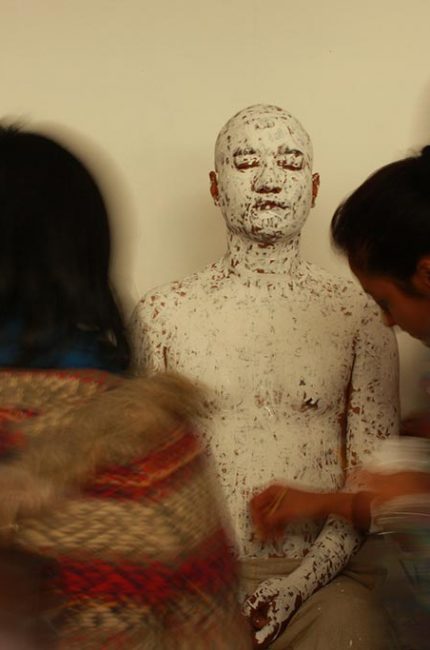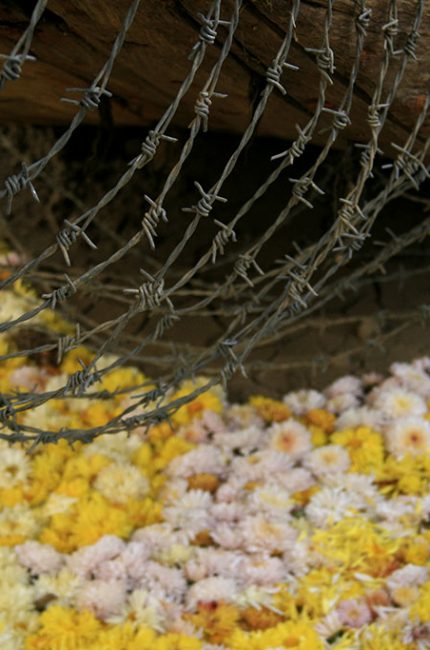
Let’s talk about ART, baby!
Siddhartha Art Gallery
Kathmandu
Nepal
2010-11
—
“Let’s talk about ART, baby!” explores the possibilities to include the general public in the domain of art through staged conversations. Opposed to elitism, art is a basic human instinct and integral to the development of our collective conscience. Hence people and their lived experiences make a visible impact on these works. The body of work considers the commonality to form collective visual experiences for contemplation. The artist fantasizes about different realms of his surroundings and involves the community to be a part of his process. Thus, “Let’s talk about ART, baby!” celebrates intrapersonal experiences of common people and translates them into layers of visual narratives that advocate collective ownership.
 ARTALK
ARTALK
Pranab Man Singh
It was a pleasant September evening. The sun was setting and the lights around Thamel were starting to flicker. I came upon Sujan Chitrakar in front of a small Thangka store. I broke his revere of an intricately designed mandala as I greeted him with surprise. One thing led to another, hours were adjusted and soon enough we were sipping some beer and munching on some popcorn at Sam’s Bar. What followed was free-flowing discussion on art and aesthetics, life and language, jokes and delusions. For some strange occurrence, we had decided to record our conversation, what is presented here is some of what was discussed before the beer took over.
Pranab: ….Thangka or Paubha is partly our art history. The way I see it, there a number of different ways through which art history can be viewed. There is the art history of the west, there are the Indian and Nepali art histories, and there is our individual and personal history with art. The first is academia, the last a personal quest but Nepali art history, I think, is still searching for an identity. I think this identity will only come through when Nepali artists accept, understand, and own their history through their personal art history while negotiating with western art history.
Sujan: I agree with this to some extent. For instance, my father and grandfather both were painters, so I grew up on art. But as a young artist, I used to look at art from the western perspective and in a sense neglected our traditional arts as being limited. I just saw it as a part of our religious life and our rituals – the gods were to be worshipped and respected. I’ve gotten a lot older since then….
Pranab: but our beer and our thoughts keep us young or at least allow us to maintain the illusion of youth…
(mirthful laughing, clicking of glasses and plenty of gulping)
Sujan: but as I was saying, and where I disagree with you, is that I think art cannot be categorized into these strict boundaries. Both the western and Nepali art traditions are equally my own. My art history is how I have understood and grown as an artist from all the art history I have studied and the art works I have seen.
Pranab: Academia might disagree, but I accept that such boundaries need not exist within your personal journey through art. But I sense, to really understand this, you have to tell me how you understand art and whether there is a distinction between west and east in what is art.
Sujan: I believe art is a part of the collective human psyche and integral to our development as human beings. The real importance is not where it came from but what it can teach us and how we can grow from it. I consider everything to be a part of our collective art history and a testament to our commonality and uniqueness as human beings.
Pranab: But I don’t get that sense in Nepal overall. Why is that?
(as Sujan collected his thoughts, a new beer was brought, opened, and poured as Jimi Hendrix jingled his guitar into the night)
Sujan: well, I think one aspect is how art is learned. One is the traditional way and the other is the institutionalized quote on quote western way. The traditional arts are passed down from father to son or master to apprentice. It is about learning to follow the iconography and build upon what has been done for generations. On the other hand, art institutions teach through a history that is mostly not directly relevant to Nepali society. This tradition values originality, innovation and authenticity – a direct contrast to traditional values.
Pranab: So it’s a matter of balancing the two? I’ve always found an appalling level of dislocation in many art works I’ve seen in Nepal. As if they are blind to what is around them. As if they had not even pierced the superficial layers of our society.
Sujan: Our very culture is based on this idea of respect and honor – our society still finds it incredibly hard to question our own parents, the strength of this is reflected in how hesitant students are to question their teachers. Within such an environment, questioning the gods is a difficult proposition. A good example is Karl Knapp’s plastic Buddha was not allowed to be displayed in Patan Durbar Square because it was a recycled Buddha and was thought to bring disharmony. This shows a deep conservatism in society. As a result, it is hard for artists to question their traditions – partly because they might be too scared and partly maybe because they don’t know how to question. But artists can’t always choose to remain on the safe side, they do need to start questioning and if they don’t then there is a danger that art itself will stagnate.
Pranab: Let art stagnate but, let’s keep the beer flowing.
Sujan: creativity might flow along too!
(the beer maintained a steady flow and popcorns were being popped to replace a dinner)
Pranab: Is this why with your new exhibition that you have based your paintings off photographs of urban landscapes? What I see in your urban landscapes is a desire to document a society that is rapidly changing and constantly clashing and having to negotiate between the traditional and the new. In many cases the two do not look face to face, in others they work closely together.
Sujan: The spaces and landscapes that I have chosen mean something to me. They are places where I have lived, drank tea, walked through and seen evolve. So my art works do have a historical context, but the context it is not important for the viewer. For instance, I am working from an iconic image of the people’s revolution taken by Min Bajracharya. It shows a woman rising up from the masses, screaming for democracy. What I have done is worked it into a context that asks – why wasn’t it or couldn’t it be a scream for art? Why can’t art be appreciated to such an extent that billboards start carrying huge paintings. Why can’t art be such an experience?
Pranab: You mentioned a year back that you were going to name your exhibition, “let’s talk about art, baby.” We’ve been talking about art, so almost be take a swing on this conversation, what gave you the idea behind the name?
Sujan: The title of this exhibition is inspired by a hit number of Salt n Pepa’s “let’s talk about sex, baby.” The song was released during the time when talking about sex was still considered taboo and must have made it easier to actually talk about sex and HIV/AIDS. “let’s talk about art, baby!” is the title painting of my exhibition. It shows a couple sitting and talking. I have imagined that they are talking about art. I believe art to be the output of a fundamental human characteristic. The appreciation of art and the production of art are both essentially human, but art suffers from a misunderstood elitism. The rituals, symbols, paintings and statues that form our culture are also a form of art, but this is not widely acknowledged. What is considered art, is thus, very limited. What I want to do is bring out the fact that art is all around us and we should talk about art. As an artist, I think it is my responsibility to bring this out into the public and show that art could be accessible and should be everywhere. Thus, “let’s talk about art, baby!”
Pranab: Your idea almost sounds like art using propaganda for itself or to some extent using activism to promote itself. You have been calling this new series of paintings artivities (art + activities) and claim to be involved in artivism. In doing so, you place yourself squarely as a social painter with an agenda. This emphasis on the social is a bit strange and a change from your earlier works, what brings this about?
Sujan: What I am playing with, is the idea of art being present in our daily activities. One of the key ideas behind my exhibition is the idea of taking art out into public spaces and engaging with people. One question I want to raise is why can’t random people sit around and get involved in creative activities which we call art? I once paid 3 tailors for a whole day and told them to make whatever they wanted. They made a huge mattress to cover a dabali (raised platform) they were sitting on. That is a form of a creative endeavor. What I want to do is show that you don’t need a huge deal of knowledge and specialized academic degrees to create, understand and appreciate art.
In this series of artivities, I have fantasized that people do talk about art. I believe people need to start talking about art – not just my art, but any form of art. I see this as important because without a cultivation of artistic appreciation, I do not think all this development and progress, in Nepal and globally, will result in anything but making us more barbaric. I am trying in a sense to do what social and political activism does – reach out and engage a mass of people – but not on any issue per say but on art itself. What I want to do through this artivism is get people to start realizing that art is as important as anything else in creating a peaceful and just society. On top of that, I see artivism itself to be a form of art…
The conversation continued late into the night, all other obligations forgotten, until the closing bells started ringing and we still had not had dinner. Thankfully, the roadside mo:mo: stands awaited.
SaveSaveSaveSave
SaveSave
SaveSave
SaveSave












